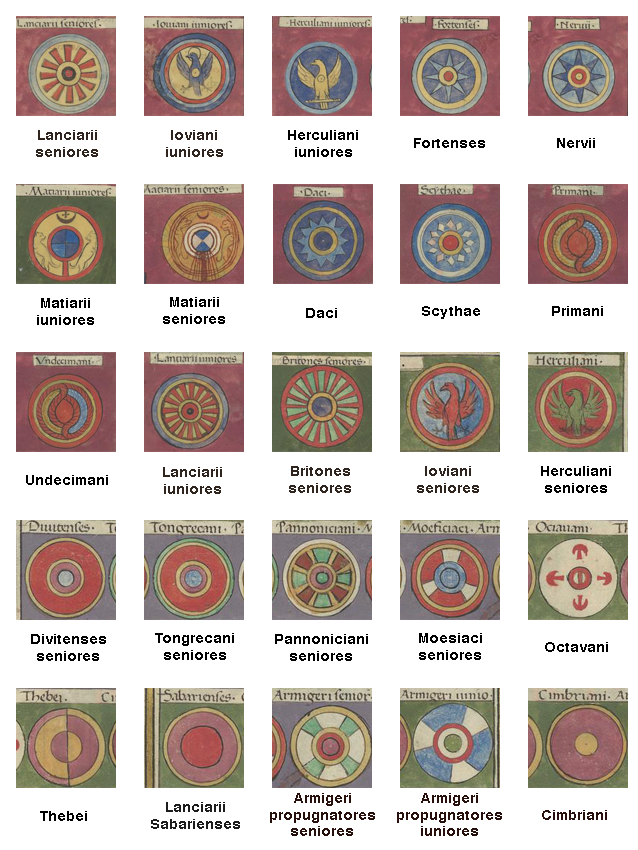
This page created 15 July 2015, and last modified: 15 July 2015

Some 25 of the units listed in the Notitia are classified as legiones palatinae; that is, legions ostensibly assigned to the (imperial) palace or court, or, to be more exact, to either of the two imperial courts, east and west, respectively:
9.17 Lanciarii seniores under the Magister Militum Praesentalis IIt can be seen that each of the two eastern Praesental Magistri have six such legions, and these are balanced by the 12 legions listed in the west. The single palatine legion under the eastern Magister Militum per Illyricum, the Britones seniores, is thus something of an anomaly. The twelve western legions can also be split into 2 groups of six, albeit not defined by their assigned commands, but rather by longevity of palatine status, for the position of these units in the distribution section of the Notitia (102/5.53 ff, as given above), as opposed to their position in the Magister Peditum's infantry roster (98/9.21 ff), makes it clear that six of these units were previously legiones comitatenses at some point: the Octavani, Thebei, Lanciarii Sabarienses, Armigeri propugnatores seniores, Armigeri propugnatores iuniores, and the Cimbriani.
9.18 Ioviani iuniores, also under the Magister Militum Praesentalis I
9.19 Herculiani iuniores, also under the Magister Militum Praesentalis I
9.20 Fortenses, also under the Magister Militum Praesentalis I
9.21 Nervii, also under the Magister Militum Praesentalis I
9.22 Matiarii iuniores, also under the Magister Militum Praesentalis I
12.16 Matiarii seniores, under the Magister Militum Praesentalis II
12.17 Daci, also under the Magister Militum Praesentalis II
12.18 Scythae, also under the Magister Militum Praesentalis II
12.19 Primani, also under the Magister Militum Praesentalis II
12.20 Undecimani, also under the Magister Militum Praesentalis II
12.21 Lanciarii iuniores, also under the Magister Militum Praesentalis II
21.6 Britones seniores, under the Magister Militum per Illyricum
102/5.54 Ioviani seniores, in the Magister Peditum's Italian command
102/5.55 Herculiani seniores, also in the Magister Peditum's Italian command
102/5.56 Divitenses seniores, also in the Magister Peditum's Italian command
102/5.57 Tongrecani seniores, also in the Magister Peditum's Italian command
102/5.58 Pannoniciani seniores, also in the Magister Peditum's Italian command
102/5.59 Moesiaci seniores, also in the Magister Peditum's Italian command
102/5.79 Octavani, also in the Magister Peditum's Italian command
102/5.80 Thebei, also in the Magister Peditum's Italian command
102/5.134 Lanciarii Sabarienses, in the Magister Equitum's Gallic command
102/5.194 Armigeri propugnatores seniores, under the Comes Africae
102/5.195 Armigeri propugnatores iuniores, also under the Comes Africae
102/5.197 Cimbriani, also under the Comes Africae.
Quite possibly these six were promoted as a result of losses among the western forces during the period in which the Notitia was being updated, which saw not only the over-running of Gaul by barbarian invaders in 407 and the sacking of Rome itself in 410, but also an unending sequence of revolts by Roman generals and other usurpers. In this regard, the lack in the Notitia of iuniores counterparts to the Britones seniores, Divitenses seniores, Tongrecani seniores, and Moesiaci seniores is instructive.
The status of the three African-based units is particularly notable, is it not obvious why these units should be called "palatine" if they were not based near the western emperor (for this period, mostly safely ensconced in Ravenna), as opposed to being standard "comitatenses" units under a Comes rather than a Magister. It may be that palatine status was something units kept even if transferred out of a praesental army into a comital one (certainly, there is no such thing as units of "auxilia comitatenses" to be found in the Notitia); on the other hand, none of the cavalry units under the Comes Africae have palatine status, not even the one unit of scholae, so why this should occur with infantry but not cavalry is even less clear.
The shield patterns of the 25 units are given below, taken from the Parisian manuscript ( P):

What strength these units were is an open question. Zosimus records that "the" Ioviani and Herculiani were each 6000 strong, but that was specifically at the time of Diocletian and Maximian, 100 years before the compilation of the Notitia, and probably before their cavalry components had been split off, and certainly before they were split into seniores and iuniores.

Return to the Notitia index page.